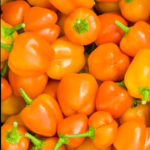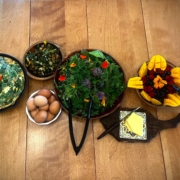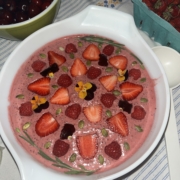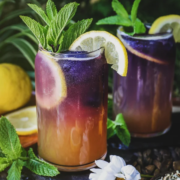UPCOMING EVENTS
with Jen Halima
Create herbal remedies with locally grown plants.
Classes will be the final Saturday of the month at Tonic Herb Shop, from 2:00-4:30
$45 per class

October 26 ~ Herbal Oxymels & Fire Cider
Get ready for the turn of the seasons with an immune supporting and warming batch of fire cider. We will explore various preparations of herbal oxymels and blend our own batch of fire cider with locally harvested herbs, roots and warming spices for each participant to take home, looking through the lens of herbal energetics to consider the ingredients we choose.
+++++++++++++

November 23~ Locally grown Incense & Smoke Bundles
Together we will make herbal burn bundles and incense cones from locally grown and harvested plants: Sweet Annie (Artemisia annua), Sweet grass (Hierochloe odorata), Mugwort (Artemisia vulgaris) & Lavender (Lavandula spp.)
+++++++++++++

Food As Medicine Series
with Bailey Ballenger
This four-part series focuses on incorporating medicinal plants into food. Each class will involve preparing one or two recipes that we’ll make & taste together. Classes will meet from 3-5 pm above Tonic Herb Shop on the following Sundays:
Nov. 3rd~ Herbal Powders and spices

Incorporating immune boosting herbal powders like into baked goods, lattes & more! Featuring astragalus, ashwagandha, and cordyceps.
Also in this series:
~Herbal Infused Broths & Soups ~ Jan 5th
~ Infused Cooking Oils & Butters ~ March 9th
~ Fresh Foraged Herbs: Pestos, Dips & Vinegars ~ May 4th
+++++++++++++
Nov. 16th ~ Herbal Cordials & Mocktails

with Meaghan Thompson
n this two-part workshop we will go over how to make an herb infused cordial for participants to take home. After a short break we will learn how to make herb infused mocktails for those who do not consume alcoholic beverages and will make some mocktail preparations for participants to take home. This workshop will be full of taste testing. Materials and some light snacks will be provided.
1:00-2:30pm~ Cordials
3:00-4:30 ~ Mocktails
$45 per session, or $80 for both
+++++++++++++

SUNDAY MORNING TEA CEREMONIES:
with Silvy Franco
Join Silvy for a meditative ceremony to commune with Camelia sinensis. Ceremony begins at 10:00 am and goes for an hour. Pre-registration is required. Suggested Donation: $20




Chickweed
/in Herb of the Month /by Ashley Davis(Stellaria media)
Ahhh, Chickweed. It’s such a refreshing sight this time of year. Its clumping, succulent carpets of bright green scream fresh new life after winter. It might be my favorite wild edible plant, partly because of its abundant accessibility, and partly because my body is so excited for a bite of fresh wild green nourishment this time of year. You can experience the full vitality of eating fresh greens by getting on your hands and knees, and taking a bite directly from the earth as if you were a rabbit:) It’s such a different sensation than eating even the freshest greens from the grocery store or farmers market. And this is what I unabashedly do when I first encounter this plant each year. I bow down and give thanks for this delicious & welcome gift.
Tastes/Energetics: cooling & moistening
Parts Used: aerial parts
Actions: nutritive, antiscorbutic, anti-pyretic, demulcent, emollient, vulnerary, pectoral, diuretic
Uses: Chickweed is primarily used either internally as a nutritive herb with cooling and detoxifying properties, or externally as a soothing remedy for cuts, itching, or irritation. Chickweed contains saponins, soap-like plant chemicals that emulsify and increase permeability of cellular membranes, thus, increasing the absorption of nutrients, promoting the excretion of metabolic waste, dissolving phlegm, neutralizing toxins, and even weakening bacterial cell walls, rendering them more vulnerable. Chickweed also has a reputation for dissolving cysts, especially ovarian cysts, and some wise country women say it helps with weight loss (soap dissolves fat). Chickweed is very soothing to the bladder & kidneys and is used as a cooling diuretic for cystitis.
Indications: signs of heat (fever, infection, coughs with yellow, concentrated mucus, inflammations, any condition ending with “itis”), chronic UTIs, internal or external wounds (to draw out splinters or infection, reduce swelling & inflammation), rashes (including chickenpox, measels, diaper rash, bug bites, or poison ivy), pink eye (as a wash), internally to support weight loss or dissolution of cysts.
Preparations: Internally as a tea, tincture, or fresh plant. Externally as a poultice, salve, or wash.
Cautions: None cited in literature.
2 cups chickweed
2 cloves garlic
1/4 cup olive oil
I TBSP lemon juice
optional:
3-4 oz hard cheese
3-4 oz nuts or seedsPlace chickweed, nuts & garlic in a food processor and blend until finely minced. Add the cheese, oil & lemon juice and process until blended. Transfer to a small bowl or tupperware & store in the refrigerator.Identification: Chickweed is out now, thanks to the warm weather & rain. You can often even find it growing under the snow. If you wish to harvest, remember to find a place away from the roadside & chemical sprays, and to harvest no more than 1/3 of what you find. I highly recommend that you get a field guide to help you with identification. It can be difficult early in the season, before the plant is in bloom. Here are some hints:The leaves of chickweed are small, ovate, oppositely arranged, and a little fuzzy. The leaves and stems have an almost succulent quality. This becomes more apparent as the plant matures. The stems are a little hairy, and if you look closely at the nodes, you’ll notice that these hairs change direction around each node. The flowers are also tiny and white in color. They appear to have 10 petals, when in reality they are 5 petals, each one deeply cut into 2 lobes. Happy Hunting!